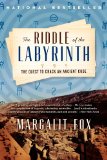Summary | Excerpt | Reviews | Beyond the Book | Readalikes | Genres & Themes | Author Bio

Critics' Opinion:
Readers' Opinion:
First Published:
May 2013, 384 pages
Paperback:
Apr 2014, 400 pages
 Book Reviewed by:
Book Reviewed by:
Poornima Apte
Buy This Book
Prologue
Buried Treasure
Knossos, Crete, 1900
The tablet, when it emerged from the ground, was in nearly perfect condition. A long, narrow rectangle of earthen clay, it tapered toward the ends, resembling a palm leaf in shape. One end was broken: That was not surprising, after three thousand years. But the rest of the tablet was intact, and on it, inscribed numbers were plainly visible. Alongside the numbers was a series of bewildering symbols, which looked like none ever seen.
In the coming weeks, workmen would lift from the earth dozens more tablets, some fractured beyond repair, others completely undamaged. All were incised with the same curious symbols, including these:

The tablets were what Arthur Evans had come to Crete to find. It had taken him only a week to locate the first one, but his discovery would forever change the face of ancient history.
* * *
On Mar ch 23, 19OO , Evans, a few carefully chosen assistants, and thirty local workmen had broken ground at Knossos, in the wild countryside of northern Crete near present-day Heraklion. There, not far from the sea, on a knoll bright with anemones and iris, Evans had vowed years earlier that he would dig.
He was rewarded almost immediately. Even before the first week was out, his workmen's spades turned up fragments of painted plaster frescoes in still-vivid hues, depicting scenes of people, plants, and animals. Digging deeper, they found pieces of enormous clay storage jars that reassembled would stand tall as a man. Still farther down, they encountered rows of huge gypsum blocks, the walls of a vast prehistoric building.
Evans had come upon the ruins of a sophisticated Bronze Age civilization, previously unknown, that had flowered on Crete from about 1850 to 1450 B.C. Predating the Greek Classical Age by a thousand years, it was the oldest European civilization ever discovered.
At forty-eight, Arthur Evans was already one of the foremost archaeologists in Britain. His discovery at Knossos, which the newspapers swiftly relayed around the globe, would make him among the most celebrated in the world. For the sprawling building beneath the knoll, he soon concluded, was none other than the palace of Minos, the legendary ruler of Crete, who crops up centuries later in Homer's epic poems, the Iliad and the Odyssey.
As Classical Greek myth told it afterward, King Minos had presided over a powerful maritime empire centered at Knossos. He held court in a huge palace resplendent with golden trea- sures and magnificent works of art, oversaw a thriving economy, and controlled the Aegean after making its waters safe from piracy. He was said to have installed an immense mechanical man, known as Talos and made of bronze, to patrol the Cretan shore and hurl rocks at approaching enemy ships.
It was for Minos, legend held, that the architect Daedalus had built the Cretan labyrinth, which housed at its center the fearsome Minotaur—half-man, half-bull. And it was Minos's daughter, Ariadne, with her ball of red thread, who helped her lover, Theseus, escape from the labyrinth, where he had been sent to be sacrificed. As Evans's prolonged excavation would reveal, the palace at Knossos spanned hundreds of rooms linked by a network of twisting passages. Surely, he would write, this vast complex was the historic basis of the enduring myth of the labyrinth.
Unseen for nearly three thousand years, the Knossos palace was hailed as one of the most spectacular archaeological finds of all time, "such a find," Evans wrote, "as one could not hope for in a lifetime or in many lifetimes." In his first season alone, he uncovered an exquisite marble fountain shaped like the head of a lioness, with eyes of enamel; carvings of ivory and crystal; ornate stone friezes; and, still more impressive, a carved alabaster throne, the oldest in Europe.
From The Riddle of the Labyrinth by Margalit Fox © 2013 Margalit Fox. Reprinted courtesy of Ecco, an imprint of HarperCollins Publishers.





The Flower Sisters
by Michelle Collins Anderson
From the new Fannie Flagg of the Ozarks, a richly-woven story of family, forgiveness, and reinvention.

The House on Biscayne Bay
by Chanel Cleeton
As death stalks a gothic mansion in Miami, the lives of two women intertwine as the past and present collide.

The Funeral Cryer by Wenyan Lu
Debut novelist Wenyan Lu brings us this witty yet profound story about one woman's midlife reawakening in contemporary rural China.
Your guide toexceptional books
BookBrowse seeks out and recommends the best in contemporary fiction and nonfiction—books that not only engage and entertain but also deepen our understanding of ourselves and the world around us.